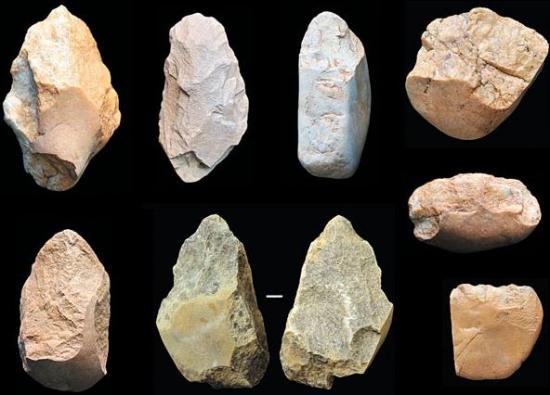Chinese Institute of Archaeology
Source - http://www.kaogu.cn/en/detail.asp?ProductID=4318
In order to coordinate with the infrastructure, Archeological Institute of Guangdong province organized an archaeological investigation team to carry out a survey on the project areas from March to June of 2012 and found some clues about a few Paleolithic cultural remains in the reaches. Again, Archaeological Institute of Guangdong province, Yunfu Museum, Yunan Museum and Luoding Museum, jointly carried out a Paleolithic archaeological investigation in the Nanjiang River reaches from November of 2012 to January of 2013.
This investigation got significant achievements. In Yunan county and Luoding city of the Nanjiang River reaches, more than 60 Paleolithic sites were found and over 200 pieces of lithic samples were collected. These Paleolithic remains could trace the historic chronology of Guangdong province back to hundreds of thousands years before present from the current 130 thousand years.

The Nanjiang River reaches are mostly hilly but the Luodinghong Basin exists in the southeast Yunan and the middle and north Luoding region, which is in Nanjiang River middle reaches. The Paleolithic sites found from this investigation were all on open field and distributed on the terraces on both sides of the middle Nanjiang River reaches. The majority were found on the third and fourth terraces, while only one site, Dongshuikou, was found on the second terrace.
The Nanjiang River Paleolithic sites were mainly distributed in Hekou town and Dawan town, Yunan county, which is in the northeast of the basin, while a few sites were distributed in the Huashi town and the Luoping town, Luoding city. The distribution of the Paleolithic sites in the Hekou and the Dawan towns were very dense because there were more than 50 sites found in an area of about 20 square km. Heavy water and soil loss happened on the terraces of both sides of the Nanjiang River so that the lithic artifacts were mostly exposed on the ground and terrace deposits only existed at the sites in Yunan Modaoshan, Weiding, Guzengxi, Wachangtou and Tandong. Many lithic artifacts were collected from the Modaoshan and the Tandong sites. Some lithic artifacts from No.1 location at Modaoshan site were collected from the laterite deposit with net pattern above the gravel layer at the bottom of the fourth terrace. Also the net pattern trace was often found on the surface of lithic artifacts collected from the ground. The terrace deposit from this site was over 20 meters in thickness.

Lithic artifacts from this region
The lithic artifacts collected in this investigation were mainly lithic tools and a few stone flakes, cores, blocks and so on. The materials were mostly quartzite, sandstone and quartz. The lithic tools were mainly made directly from gravel but a few used flakes as blanks to take the retouching works. The flaking techniques were mainly hammer percussion and the retouching techniques were mostly uni-side hard hammer processing. The edges of some stone tools were made by applying turning directional processing and staggered directional processing techniques. Bi-side processing technique could be observed on hand axes and a few hand picks. There were many lithic types, including hand axes, hand picks, choppers, scrapers, small points, notched scrapers and so on. Among the lithic types, the majority was hand picks, then choppers and scrapers. According to the characteristics and the shapes of edges, hand picks could be classified into ligulate hand picks, triangular prism picks, spear-shaped hand picks, short-edge hand picks and so on, while the ligulate hand picks were the majority. Each stone tool was relatively thicker and bigger, for example, the length of hand picks and choppers was normally more than 10cm and some of them were even over 20cm. While it is worth to note that, besides the macrolithic pebble tools, a small number of smaller flake scrapers and points were found which were no more than 10cm in length and were only about 5cm for the smallest ones. Considering that the lithic artifacts were collected from different terraces, the Paleolithic cultures in the Nanjiang River reaches possibly has different features in different stages.
The Paleolithic assemblage has obvious typical features of the pebble tools industry in Southern China, which is to take pebble as the raw material, use simple unidirectional processing as the main technique and take the hand picks and choppers as the tool assemblage, so that these Paleolithic artifacts belonged to the same pebble tools industry system as the Paleolithic cultures in Guangxi Baise, Hunan Lishui, Anhui Shuiyang River and Han River reaches. Ligulate hand picks and hand axes were the typical tools among the Nanjiang River Paleolithic sites cluster, showing the Nanjiang River Paleolithic culture was closer to the Guangxi Baise’ in archaeological culture, but was a little different from the Paleolithic cultures in other regions. It represents the close relationship in the cultural origin between Guangdong and Guangxi provinces in the late Paleolithic cultures.
In March 2013, Guangdong provincial Institute of Archaeology invited some experts studying on Paleolithic archaeology in Southern China and the Quatenary Period geology from Peking University, Hunan provincial Institute of Archaeology, Guangxi provincial Institute of Archaeology, to have an on-the-spot investigation. After carefully observing the lithic tools and the related sites, the experts group confirmed the lithic artifacts collected from the investigation to be able to be dated to the early Paleolithic period, and the earliest even could be dated to the middle Pleistocene Epoch. These artifacts belonged to the early Paleolithic Period and the applied technology belonged to the pebble tools industry in Southern China. As culture feature, they were basically the same as those in the Baise Basin in Guangxi.
The Nanjiang River Paleolithic artifacts were bulky, variable in type and the related sites were distributed densely. Their chronology is far earlier than the fossil’s of Maba Man, therefore they are the earliest ancient cultural remains in Guangdong so far. It indicates that human being have started living on both sides of the Nanjiang River, which is one of the branches of the Xijiang River, in the early Paleolithic Period dating to hundreds of thousands of years before present. (Translator: Zhai Shaodong)